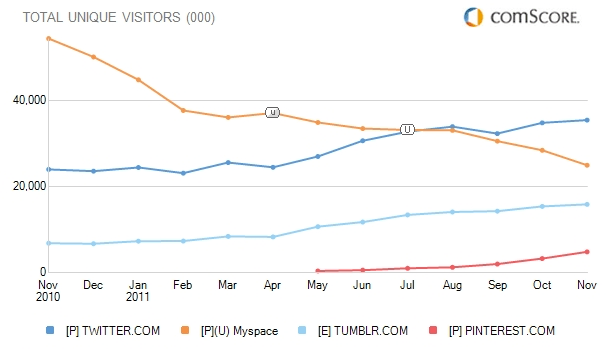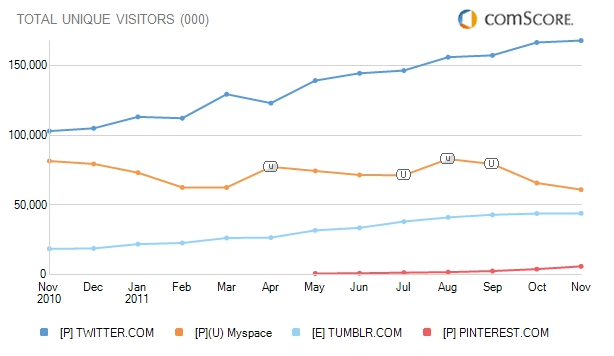One of the most interesting trends in comScore’s 2011 social networking report is the new growth of social sites that cater to users’ interests, rather than their real-life social graphs. In particular, according to comScore data, microblogging platforms Twitter and Tumblr have had break-out years, and they’ve been joined by new online pinboard site Pinterest.
But all this growth doesn’t seem to be coming at the expense of Facebook. That site’s traffic growth has only appeared to slow (but not fall) in places where it is running out of new users to add. The site that has been taking a beating is MySpace. It may be that users who previously used that site to express themselves and follow the celebrities they care about are now doing the same thing across these other sites.

Twitter has the most fascinating story here. The short-form messaging service hit the mainstream in early 2009, and received an amazing amount of media hype — but third-party measurement firms like comScore mostly showed flat traffic in the US since then, with monthly visitor numbers ranging between 20 million and 25 million, according to comScore.
And even this year started out slow. In April, the company had 24.5 million unique visitors. But, from May through November the company grew to 35.5 million. Twitter’s worldwide numbers have looked just as strong. In the past 12 months, it has grown from 103.0 million uniques to 167.9 million overall. Yes, this growth was likely in part due to its integration with iOS 5, which the companyrecently said has led to a 25% increase in sign-ups. However, the integration only went live in October, which doesn’t explain all the new usage over the summer.
What’s even more interesting is that the company itself has consistently said that third-party services undercount its traffic. In September, for example, it announced that it had grown to 400 million unique visitors worldwide based on its Google Analytics stats, up from 250 million at the start of the year. Many of its visitors don’t actually tweet, or aren’t even signed up. At that point it said it had 100 million active users (and it reiterated the same number in December).
So, the comScore visitor numbers don’t exactly match up with the internal ones, but the trend is the same: more people are reading tweets than ever before. The five year old company appears to have finally made it past the ups and downs of the hype cycle, and become a solid and growing part of how mainstream people use the web.

Tumblr, which will turn five early next year, has also been coming of age. From November of 2010 to last month, it has grown from 6.9 million unique visitors to 15.9 million in the US. Worldwide, its new traffic is just as pronounced, going from 18.6 million to 44 million in the same period.
A new interest-oriented site has also gotten into the mix: Pinterest. Although the company has been around since 2008, it only began sending out invites in early 2010. It has taken off this year, going from less than a million in May, according to comScore, to more than 6 million uniques worldwide in November.
MySpace may not be losing users directly to these pseudo-rivals, but it’s definitely continuing to hurt. Worldwide, it has fallen from 81.5 million to 61.0 million from November to November. And in the US, the drop is even more pronounced, dropping from 54.4 million to 25.0 million.
Based on all these numbers, 2011 is looking like a banner year for the next era of public self-expression and sharing. The ugly, hacked-up MySpace user profiles of past years are less popular than ever, and users are busy sharing through their beautiful Tumblr themes, through Twitter’s simple 140-character messaging service, and through their online Pinterest pinboards.
What can we expect in 2012? Can Facebook’s new public sharing features like its Subscribe button tap into all the attention these other sites are getting? Early signs indicate yes. And just where is all this usage going? It may be that 2011 is just the start of a new era, where the average internet user is comfortable sharing everything they think is interesting with the public, and following the people who are most interesting to them, not just friending those they meet in real life.
[Top graphic, which I should note is October to October not November to November, is via comScore's 2011 social network report, which you can download here.]

No comments:
Post a Comment